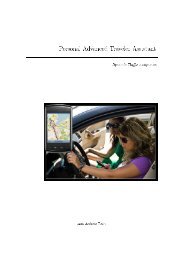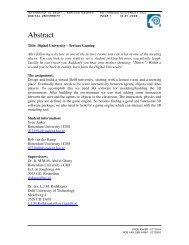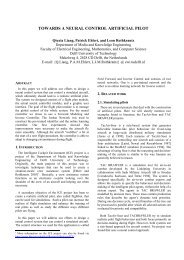Recognition of facial expressions - Knowledge Based Systems ...
Recognition of facial expressions - Knowledge Based Systems ...
Recognition of facial expressions - Knowledge Based Systems ...
Create successful ePaper yourself
Turn your PDF publications into a flip-book with our unique Google optimized e-Paper software.
In [Wang and Tang, 2003] the authors proposed a combination <strong>of</strong> a Bayesian<br />
probabilistic model and Gabor filter. [Cohen et al., 2003] introduced a Tree-Augmented-<br />
Naive Bayes (TAN) classifier for learning the feature dependencies.<br />
The system presented in [Bartlett et al., 2003] is able to automatically detect frontal faces<br />
in video and to code the faces according to the six basic emotions plus the neutral. For the<br />
detection <strong>of</strong> faces, the authors use a cascade <strong>of</strong> feature detectors based on boosting<br />
techniques. The face detector outputs image patches to the <strong>facial</strong> expression recognizer.<br />
A bank <strong>of</strong> SVM classifiers make use <strong>of</strong> Gabor-based features that are computed from the<br />
image patches. Each emotion class is handled by a distinct SVM classifier. The paper<br />
presents the results for the algorithms that involved linear and RBF kernels for being used<br />
by the SVM classifiers. Adaboost algorithm was used for select the relevant set <strong>of</strong><br />
features from an initial set <strong>of</strong> 92160 features.<br />
[Jun et al., 2000] propose a system for the recognition <strong>of</strong> <strong>facial</strong> <strong>expressions</strong> based on<br />
Independent Component Analysis - ICA algorithm and Linear Discriminant Analysis -<br />
LDA. The algorithm implies the use <strong>of</strong> ICA for obtaining a set <strong>of</strong> independent basis<br />
images <strong>of</strong> the face image and the use <strong>of</strong> LDA for selecting features obtained by ICA. The<br />
authors provide the results for each experimental setup for the use <strong>of</strong> the two methods.<br />
They report the highest recognition ration for the case <strong>of</strong> using LDA and ICA together<br />
(95.6%).<br />
[Feng et al., 2000] proposes a sub-band approach in using Principal Component Analysis<br />
– PCA. In comparison with the traditional use <strong>of</strong> PCA namely for the whole <strong>facial</strong> image,<br />
the method described in the paper gives better recognition accuracy. Additionally, the<br />
method achieves a reduction <strong>of</strong> the computational load in the cases the image database is<br />
large, with more than 256 training images. The <strong>facial</strong> expression accuracy ranges from<br />
45.9% in the case <strong>of</strong> using 4X4 wavelet transform to 84.5% for a size <strong>of</strong> 16X16. The<br />
accuracy <strong>of</strong> the recognition is improved by 6%, from 78.7% in case <strong>of</strong> using the<br />
traditional approach to 84.5% using sub-band 10. The analysis are carried for wavelet<br />
transform ranging from sub-band 1 to sub-band 16 and full size original image.<br />
- 18 -
















